#Cabochon Cut Emerald Jewelry
Photo

Diamond Emerald Platinum Drop Earrings 15478-2447
Elevate your elegance with our Platinum Drop Earrings, featuring 1.00ct cabochon-cut emeralds and a cascade of diamonds totaling 1.75cts, including cushion, brilliant, and single cuts. A luxurious blend of sparkle and sophistication. 💚✨
Details: ±1.00ct Emeralds, ±0.40ct Cushion-cut diamond, ±0.65ct Brilliant-cut diamond, ±0.70ct Single-cut diamond, Platinum Earrings *.
Dimensions: 33 x 10.5 mm.
Weight in grams: 7.5.
Condition: Very good condition - slightly used with small signs of wear.
Shipping and Pickup: This charming piece ships from our store located in the center of Amsterdam, The Netherlands. We offer both registered shipping and local pickup at our store. In the case of local pickup, any applicable shipping costs will be refunded.
About Us: Add some sparkle to your style with Binenbaum.com. We offer a stunning selection of antique and vintage jewelry that you won't find anywhere else. From timeless rings and dazzling necklaces to unique brooches, we have something for every taste and occasion. Visit our website today and treat yourself to a piece of history.
#Brilliant Cut Diamond Accessories#BrilliantCutDiamonds#Cabochon Cut Emerald Jewelry#CabochonEmeralds#Cushion Cut Diamond Earrings#DiamondDropEarrings#Elegant Gemstone Earrings#ElegantAccessories#EmeraldEarrings#High-Quality Platinum Earrings#Luxury Diamond and Emerald Earrings#LuxuryEarrings#Platinum Emerald Drop Earrings#PlatinumJewelry#Single-Cut Diamond Earrings#TimelessElegance
2 notes
·
View notes
Text
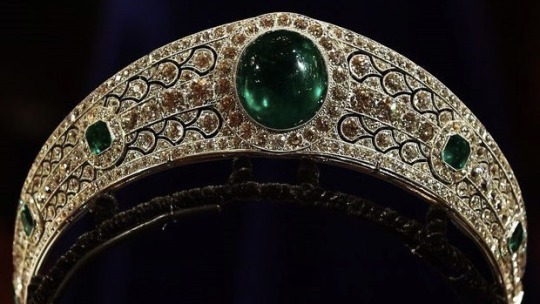
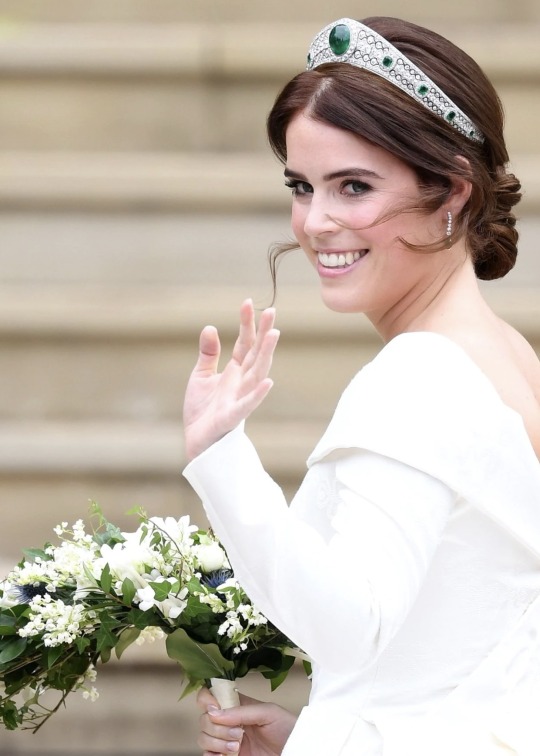

Royal Tiaras Highlights: Margaret Greville's Emerald Kokoshnik Tiara
The tiara was made in 1921 by Boucheron for Dame Margaret Greville, who famously bequeathed her jewelry to Queen Elizabeth (the Queen Mother) in 1942. The diamond and emerald tiara, which features a large cabochon emerald as its central element, was made in 1919, two years earlier than previously stated. The press release from the palace - released on Princess Eugenie’s wedding day - described the tiara as “made of brilliant and rose cut diamonds pavé set in platinum, with six emeralds on either side.” The release also noted that the tiara’s design was inspired by the kokoshniks that had been popular at the imperial court of the Romanovs in Russia.
Via The Court Jeweler
#tryna clean up my notes lmao#princess eugenie#brf#tiaras highlights#royal tiaras#royal jewels#royal jewelry
58 notes
·
View notes
Text
Kyanite: A Gemstone With Hidden Depths
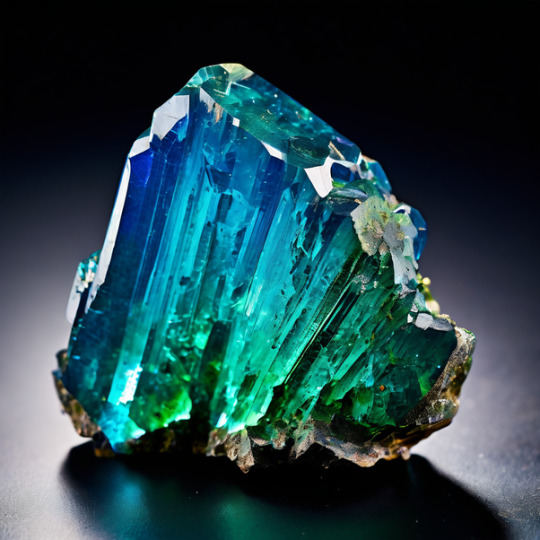
Kyanite isn't your everyday diamond or sapphire, but it holds a charm all its own. This unique gemstone offers a captivating play of color and a touch of rarity, making it a valuable choice for those who appreciate something special.
The Blade That Shifts Color
Kyanite's most striking feature is pleochroism. This means the gem changes color depending on the angle you look at it! Imagine a sapphire blue stone that transforms into emerald green with a tilt of your head - that's the magic of kyanite. This characteristic makes it a favorite among collectors who cherish unique gems.
Beauty with a Side of Caution
While fairly durable (ranking 7 on the Mohs scale), kyanite has a blade-like crystal structure. This means it can chip or scratch if struck in a specific direction. Don't worry though, skilled jewelers can work around this by using protective settings or cabochon cuts (smooth, polished domes) to minimize risk.
A Spectrum of Value
Kyanite comes in a variety of colors, with deep blues and greens being the most sought-after. Rarer colors like orange or pink can be even more valuable. Here's what affects a kyanite's worth:
Color: Vivid blues and greens fetch a higher price.
Clarity: Flawless stones are rare, but inclusions (tiny flaws) are okay if they don't affect the beauty.
Cut: A well-cut kyanite with good brilliance and fire adds value (faceting kyanite can be tricky).
Size: Larger, high-quality kyanites are naturally rarer and more expensive.
Generally, prices range from $6 per carat for lower qualities to a whopping $600 per carat for exceptional specimens.
More Than Just a Pretty Face
Kyanite's value extends beyond aesthetics. Its high aluminum content makes it valuable in the production of high-quality porcelain and refractory materials. This adds another layer of value to the stone, especially for industrial purposes.
So, Is Kyanite Valuable?
Absolutely! It depends on what you're looking for. For jewelry, kyanite offers a captivating play of color and a conversation-starting rarity. It might not be the most durable gem, but its beauty and uniqueness make it a valuable choice for those who appreciate something special. In the industrial world, its properties make it a valuable material as well.
Kyanite's worth lies in its distinctive character, captivating colors, and the way light dances within its crystalline form. It's a true gem with hidden depths!
18 notes
·
View notes
Text
I’ve been down a rabbit hole wondering about medieval jewelry (and if I can reproduce it despite having no metalworking skills, to which the answer is mostly no) lately & I figured I would share the fruits of my museum collection searches for other medievalists/hobbyists/reenactors/nerds.
Jewelry of the 13th Century Anglo/Francosphere

TL;DR
Metals: 🟨 gold(tone)
Stones: mostly 🔵 cabochon, rarely 💠 simple cut, some carved 🗿 intaglio or cameo
Stone Colors: warm blues, emerald green, purples, burgundies, reds
Materials: enamel, 💎 gemstones (garnet, Ceylon sapphire, ruby/spinel, emerald) or glass paste imitations, ⚪ semi-precious stones (pearl, lapis, jasper, carnelian, coral, turquoise, porphyry)
Settings: bezel (oval and rectangular); ⚜️ intricate metalwork; more visible and textured metal than modern jewelry; more mixtures of stones and colors than modern tastes
Motifs: ◯ round, ✤ quatrefoil, ✙ cross, ✸ star (even numbers of points), ♣ trefoil, ❦ floral, 🐉 animals, 𝕬 inscription
Formats: brooches, ornamented clothing, rings, pendants, circlets, cuffs (rare)
A detailed look:
Some forms of jewelry that were very popular in the Roman Empire and are again today were just not the thing in the middle European Middle Ages. (Earrings, for example, seem to have barely existed. This is partially at least because ears were covered--by coifs and caps, hair, and (for women) braids or the chin strap and fillet/wimple/gorget.) In fact, a lot of the places we would put jewelry against our skin today were covered.
This left some other options:
Jewelry on Clothing
Medallions
Okay, these aren’t jewelry, strictly speaking, but they’re metalwork ornaments associated with a person.
Enamel Mitre Medallions


OA 3437 and OA 3438
Before 1291, Ile de France
Louvre, Paris
photos (c) Musée du Louvre / Stéphane Maréchalle 2015
Cloisonné and plique enamel over gold and copper, with decorative motifs of trefoils, quatrefoil, and stars in a palette of dark blue and green with accents that may once have been ruby red.
Appliqué Medallion
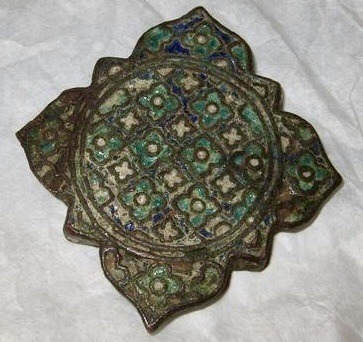
# MRR 256
13th c., Limoge
Louvre, Paris
photo (c) Musée du Louvre 2014
Gilded copper (though most gold is worn off) with quatrefoil champlevé enamel in emerald green, lapis blue, and white or off-white.
Brooches
Perhaps the most prevalent medieval jewelry item in the Anglo & French regions. These were worn at the shoulder for men and breast for women, often anchoring a cloak, or to close the collar. As the ornate fermail and double-ring brooch suggest, these ran the gamut from practical to incredibly decorative and ornate.
Garnet & Silver Gilt Animal Ring Brooch; Green and Blue Glass and Gilt Ring Brooch


Left, # 2003,0703.1
13th century; found in Suffolk, England
British Museum, London
photo (c) The Trustees of the British Museum
Right, # M.28-1929
13th c., England
V&A, London
photo © Victoria and Albert Museum, London
Cabochon garnets or carbuncles in the gilded silver brooch (L), perhaps once paired with smaller stones in the eyes of metalwork animals that bite the pin bracket. The right brooch, also silver gilt, sports two glass paste emerald and sapphire "gems" in cabochon. It was probably a lover's token; it reads (in Lombardic-lettered French) IOSV ICI ATI VCI or "jo su[i] ici a t[o]i v[o]ici" which I might translate as "I am here with/belonging to you, look!"
Ruby & Sapphire Ring Brooch; Sapphire, Garnet, and Pearl Fermail
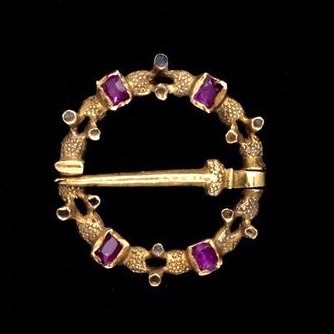
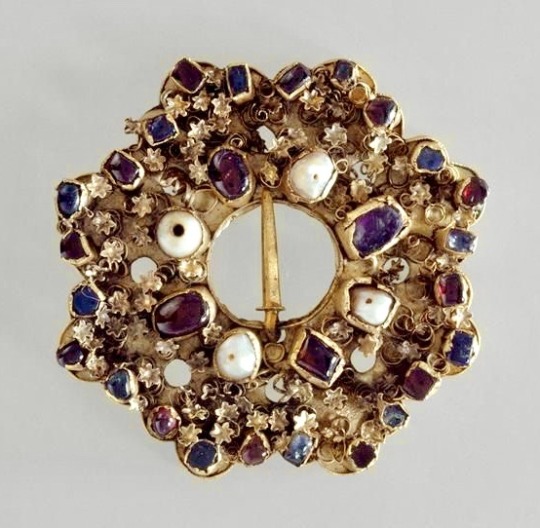
Left, # 6808-1860
1275-1300, England
V&A, London
photo © Victoria and Albert Museum, London
Right, # OA6287
1250-1300, France
Louvre, Paris
photo (c) Musée du Louvre
Blogs often claim that stones were only polished en cabochon until the 16th century, and that medieval jewelers couldn't cut gemstones. But this 13th-century gold ring brooch (left) pairs table-cut purple rubies with collet-set cabochon sapphires, and may evidence early medieval gem-cutting or reuse of Roman cut stones. The silver gilt fermail, right, includes pearl beads, garnets and sapphires both cut and cabbed, and one glass paste cabochon. Both are intricately textured, with punchwork (L) and floral metalwork, probably cast and then attached (R).
Double Ring Brooch with Sapphire and Glass "Emeralds"
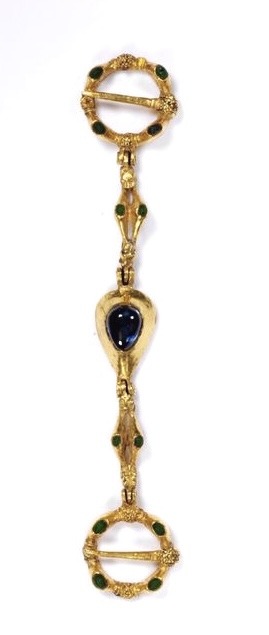
# M.26-1993
13th c., England
V&A, London
photo © Victoria and Albert Museum, London
This gold double brooch is so small they think it was for a woman or child. Central sapphire cab is flanked by glass paste "emeralds" in bezel settings and metalwork featuring two animal heads.
Jewelry on the Body
Rings
Many are probably familiar with the signet ring, used for pressing into sealing wax, which could be intaglio-carved gemstone or metals. There were also a number of decorative and/or talismanic gemstone rings.


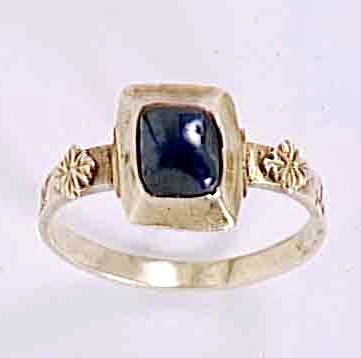
LtR:
#M.7-1929 | #M.180-1975 | #OA 11265
1250-1300, England | 1250-1300, Engl/France | 13th c., Engl/France
V&A, London | V&A, London | Louvre, France
photos L&C © Victoria and Albert Museum, London | R (c) Musée du Louvre
Sapphire in gold is the name of the game when it comes to rings in the thirteenth century; even the purple stones on the left are purple sapphires. (Sapphires were said to aid chastity, purity, and the effectiveness of prayer.) For larger stones, the bezel often has claws added (L); the central ring is an example of a full claw setting that modern viewers might find surprisingly tall. Naturalistic flourishes are added (C & R); these might be pre-cast then attached to the base (R).
Pendants
We equate pendants with necklaces, but their medieval applications also included wear as badges, from headpieces, and on horse decorations.


Left, bloodstone jasper cameo in silver setting
# MRR 218
1100-1300, France?
Louvre, Paris
photo (c) Musée du Louvre / Jean Blot 1984
Right, champlevé enamel, gilt copper, and paste "emerald" (harness) pendant
# 1976.169
13th c., France
Cleveland Museum of Art, Cleveland
photo CC0 Open Access
Statue Jewelry
From here, we get into the really ridiculous stuff; the previous categories could be relatively everyday (as much as ornamentation reserved exclusively for the wealthy can be an everyday thing) but the following examples are astonishing displays not necessarily for wear.
"La Couronne" de Vierge et l'Enfant d'ivoire de la Sainte-Chapelle

# OA 57 B
1250-1300, France
Louvre, Paris
photo (c) Musée de Louvre
This was not even a crown for a person, but rather for a painted ivory statue of the Virgin Mary, holding her infant son. (Though circlets, even set with stones, were sometimes worn as part of women's head dress.) It's incredibly ornate gold, set with pearls, garnets and rubies, sapphires, and turquoise (?) en cabochon.
Anneau de Saint-Denis




# MS 85 BIS
1200-1215, France
Louvre, Paris
photos (c) Musée du Louvre / Daniel Arnaudet 1990
This astonishing piece, which is ring-sized but now displayed as a cuff on an ivory hand, is made of gold and displays every possible gemstone appearance characteristic of the period. The front piece has a central sapphire and is surrounded by quartz with red backing (mimicking ruby/garnet), amethysts, pearls, and sapphires, some set on yellow backing (mimicking turquoise?). Most are en cabochon on this face, but two are faceted and two intaglio. Were this not enough, the three other 'faces' of the ring are set with gems as well, two cameos (probably sapphire and garnet?) and one amethyst intaglio set in ornate gold filigree.
#medieval#jewelry making#lapidary#history of fashion#historical jewelry#1200s#reenactment#England#France#enamel jewelry#ring brooch#fermail#intaglio#cameo#gemstones#infodumping#now time to go to the bead store#material history#you would think this is for my research or academically relevant but it's not I just couldn't stop looking at shiny things help#photos not mine#photos for educational purposes and not for commercial reproduction#louvre#v&a museum#british museum#cleveland museum of art
35 notes
·
View notes
Text
Grand Jewelry to Emulate
Amethyst: alluring & regal
Diamonds
Platinum
Gold
Rose Gold
Ruby: fiery & radiant
Citrine: warm & autumnal
Garnet: luxurious & ravishing
Garnet is my favorite.
Sapphire: colorful & regal
Emerald
Topaz
Blue Topaz: calming & serene
Pearl: lustrous & classic
Onyx
Lapis Lazuli
Kunzite
Chrysoberyl
Terms
Demi-parure: jewelry set w/o a tiara
Aigrette: fountain of sapphires with diamond drops
Agraffe: a brooch-like clasp
Diadem:
Cabochon
Motif
Briolette: a pear or drop-shaped gemstone which has its entire surface covered with long triangular facets.

Brands
Van Cleef & Arpels
Harry Winston
Graff
Cartier
Bulgari
Andreoli
Accounts
The Court Jeweller
Romanov Russia
Russia Beyond
Diamonds in the Library
X
Avoid trendy pieces from aforementioned brands.
Beyond basic gem cuts
Typical pieces are fine if they’re heirlooms.
II
Add worthier pendants on gold necklaces I own.
2 notes
·
View notes
Text
INSIDE THE SOTHEBY’S PLATINUM JUBILEE TIARA EXHIBITION
07.31.2022 by THE COURTJEWELLER
Earlier this summer, Sotheby’s in London mounted a truly special exhibition of tiaras, featuring royal and aristocratic pieces alongside more modern examples. Several of our lucky readers were able to visit the exhibition and see the tiaras in person, and today, I’m honored to share some photos taken by our lovely reader Phyllis!

Phyllis has generously shared a selection of her photographs, plus some of her observations about the exhibition. She notes that the presentation techniques used by Sotheby’s to present some of the diadems was truly ingenious: “The tiaras are either in cases where you can walk around 360 degrees and see them from all sides or are along the walls in niche cases. The tiaras in the niche cases actually float up and down and also spin, I spoke with a Sotheby’s employee about this and evidently the wall niches, which are actually secure vaults, use a patented technology to suspend and spin the tiaras. There are no strings! I think it must use air pressure changes to do this….it’s really cool.”
Here are two interesting tiaras are paired in a single case. The top sparkler is the Westminster Halo Tiara, made by Lacloche in 1930 for Loelia Ponsonby, the third wife of the 2nd Duke of Westminster. Sotheby’s notes that the tiara was designed “as a halo to be worn over the crown of the wearer’s head and extending outwards in the manner of a traditional Chinese headdress,” adding that it was “originally set with the Hastings and Arcot diamonds, now replaced with smaller diamonds, [and] flowers.
The second, smaller tiara in the display is a simpler silver bandeau-style tiara that dates to ca. 1920. Sotheby’s describes the jewel as “as an openwork bandeau of foliage and flowers, set at the centre with a cabochon emerald and with circular-cut sapphires and pink sapphire within the centres of the flowers.

One of the most famous tiaras displayed in the exhibition was the Spencer Tiara, which we discussed at length here on the site a few days ago. It was made in 1937 for the Countess Spencer using a set of nineteenth-century ornaments, and it was most famously worn by Diana, Princess of Wales. Sotheby’s calls the tiara “one of the most famous diadems in modern history.” (It’s tough to disagree with that statement!) Phyllis shared that “it was a real thrill” to see the tiara in person, and that it was a highlight, along with another very important royal jewel, Queen Victoria’s Emerald and Diamond Tiara.

I really love the photo that Phyllis took of the Rosebery Tiara. Her image shows the intense sparkle of the diamonds so clearly! Made in France ca. 1878, this tiara was given as a wedding present to Hannah Rothschild, the richest women in Britain, by her new husband, the 5th Earl of Rosebery. Sotheby’s explains that the tiara is “comprised of ornate scrollwork and foliate detailing in a graduated sequence of crescents within which large collet stones are set and flanked by foliate scrolls issuing stylised lilies, with a band interspersed with square and lozenge stones, set throughout with diamonds.”
Phyllis explained that she “loved seeing these tiaras in 360 views because the frames and attachments are just as interesting as the front views.” She added, “Most of them have detachable brooches and/or can be worn as necklaces. The mechanics used vary quite a bit from one tiara to the next and all are utterly unique. Some brooch backs have pin back attachments like modern jewelry but the older ones have spikes and clips.

Here are two more tiaras that shared a case in the exhibition. (It’s so fun to think through the reasons that the curators paired up certain sparklers, isn’t it?) The top tiara is a diamond waveform tiara made by Cartier in 1904. Sotheby’s describes it as “a wreath of twinned sprays of leaves, set throughout with brilliant-cut diamonds, with pendant larger diamonds to suggest flowers, detachable into four brooches, accompanied by brooch fittings.”
The lower tiara is also a Cartier creation. Made in the 1920s, it’s a bandeau-style tiara set with diamonds, amethysts, sapphires, and onyx. Sotheby’s explains that the tiara, which was made in the firm’s Paris atelier, has a “geometric openwork design, set throughout with circular-cut diamonds and three large faceted buff-top amethysts, with cabochon sapphire and onyx panel accents.” You can see this one sparkling in motion on the Sotheby’s website as well.

I love this dramatic photograph of the Derby Tiara, made around 1890, likely by Skinner & Co. This tiara has a fraternal twin: the Devonshire Diadem, made by the same firm in 1893. The Derby is slightly smaller than the Devonshire; Sotheby’s notes that the Devonshire version “features 13 palmette motifs,” while the Derby “is smaller and bears 11 palmette motifs.” Though Sotheby’s attributes the construction of the tiara to Skinner, the piece resides in a fitted Carrington & Co. Case.
Placed below the Derby Tiara is an unusual, asymmetrical tiara made ca. 1820: the Fitzwilliam Tiara. Sotheby’s explains that this early example of nineteenth-century tiara design is in “naturalist taste, designed as a long spray of flowers, leaves and buds forming a half circle, the front surmounted by crossed leafy stems centred and flanked by flowers.” The tiara is “detachable to be used as earrings and a brooch, [and] set throughout with cushion-, pear-shaped and circular-cut diamonds, with a back chain for converting the tiara as a necklace.” It’s fascinating to see the “bones” of the tiara’s construction in Phyllis’s photo.

Here's a tiara in one of the “floating” cases described by Phyllis. Sold in an auction at Sotheby’s in 2021, this golden diadem was made by Jacques-Ambroise Oliveras ca. 1805. By family tradition of the longtime owners, the Lascelles family, the tiara and its coordinating jewels belonged to Empress Joséphine of France, perhaps gifts from her sister-in-law, Caroline Bonaparte Murat. Sotheby’s has published a lengthy essay on the provenance of the tiara and its connection to Joséphine and Caroline.

And finally, we’ve got another set of jewels that particularly intrigued Phyllis: a turquoise and diamond tiara and necklace made in the 1960s by Van Cleef & Arpels. Sotheby’s notes that turquoise jewels like this suite were inspired by designs from India. And Phyllis shares even more information with us: “Another thing I learned is that the turquoise tiara has never been worn, only the necklace has been worn and just one or two times. Gem quality turquoise is a soft stone that discolors easily from body contact, hence these turquoise pieces being rarely or never worn. The uprights on that tiara also are removable and can be attached to the necklace as pendants, I think at the ‘flower base’ motif.
#the court jeweller#spencer tiara#derby tiara#Westminster halo#sotheby's#Platinum Jubilee tiara display
11 notes
·
View notes
Text
Our Precious
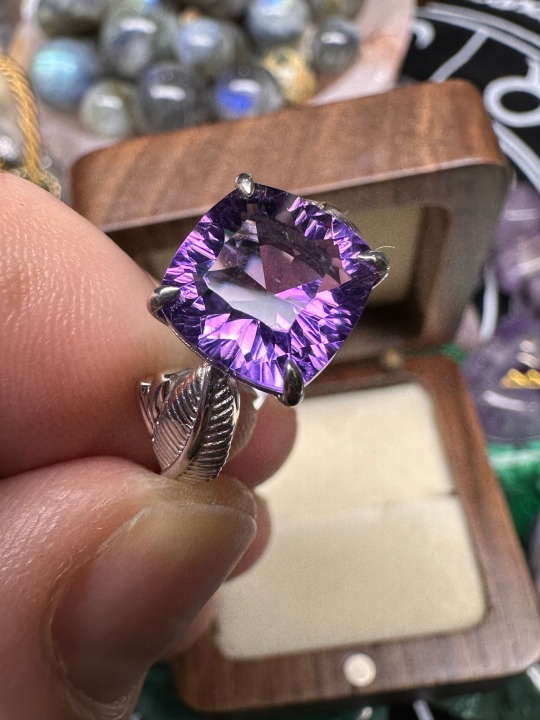
Everyone loves to have something decorative about them. It could be a brooch, a certain set of earrings, a specific hat, a universal jacket, or even just a signature color or pattern. To know you are able to be picked out of a crowd or have something that makes you “you” to someone else, it’s a great feat and pleasure. So for those who like items of a shinier persuasion… Birds of Valhalla has something special in store for you, or your loved one who does.

Hands get everywhere. Hands get dirty, scuffed, roughed, scraped, burnt, smashed, crushed, crimped, and everything else. Even though hands do a lot of work, they still get some of the best things too. They get to hold another person, show you care, and are said to lead to the heart’s intent and the life you’ve led and will lead. Soft hands “haven’t worked a day in their life” while rough hands “are hard workers and sturdy” all the while jobs and times are changing. The old sayings like that don’t work anymore, now it’s all about how you present yourself. Many people talk with their hands, gesturing and emphasizing while describing things and just expressing as much as they can through their hands. And something that always catches people’s attention is jewelry. On these busy workers of our bodies we place the most important of jewelry pieces sometimes: rings. A ring can show that you’re in a serious relationship, that someone has promised you their world, or that you truly are their one and only. A simple ring can speak volumes and just like a picture is worth a thousand words, a ring can be worth a million. They’re worth the “I love you”s and “I need you”s. They’re worth the “You make me better”s and the “I can’t do this alone”s. Rings speak to so many people that what you make, where you wear it, and what stones are in it add to the story.
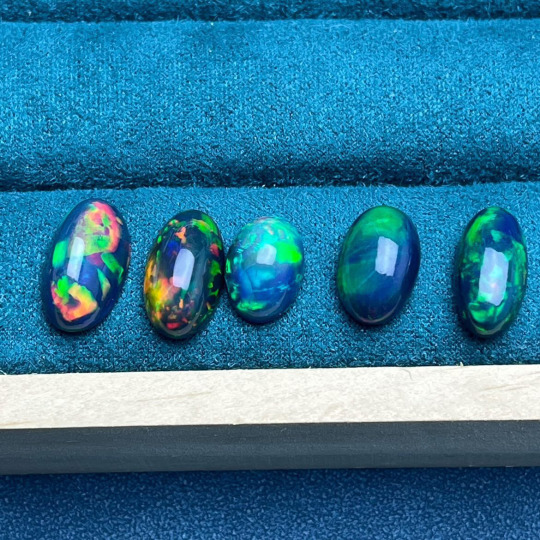
If you’ve been around Birds of Valhalla a while, you know our CEO makes sure to carry some of the best crystals on the market. She goes out of her way with the crystal shoppers to make sure you have the best selection to pick from with her crystal lives and the crystals that top her soaps. But what you may not know, is that she expects the same thing from the gems she buys. Yes. She buys gemstones from lapidaries, people who cut gems into the facets or cabochon (rounded or domed smooth top) shapes. And she buys these gems to make special items for those people interested in having a custom ring or pendant made. When you purchase one of these custom pieces, you work with Debra and select the stone, the metal, the setting, and any extra details you like.
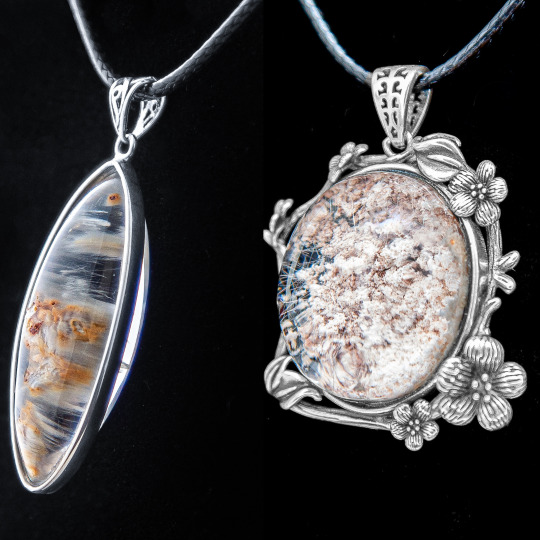
So far, customers that have bought this listing have made some beautiful pieces. Even the pieces the jeweler sends that Deb created just to have in the shop have been so well received. From black opals to peridot, to garnet and tanzanite, to ametrine and labradorite, you can have your dream piece of jewelry made just for you. And since these are one of a kind pieces, you will have your own piece of Birds of Valhalla. When you want this done, you’ll need to do a down payment, and you can give Debra a budget to work in when it comes to the stone and setting. With the design details hammered out in the early conversations and planning stages, the CEO sets off to find the best stone for you, get it matched with the setting and metal you choose, and then get it to you in a custom made box. You can choose between sterling silver and 14 karat white or yellow gold for the rings and pendants. When you choose your stone, you choose the cut of the shape: pear or teardrop, princess or square, round, emerald or rectangle, cushion or “rounded” edge square, oval, marquise or two pointed, trillion or triangle, or maybe even heart shaped. Not every stone can be cut into every shape, so it’s best to come with multiple shapes you want for your pendant or ring and make sure you have the budget for some of these stones. You need to think about the four C’s of diamonds when you’re shopping for any gemstone. If you don’t know the four C’s, let me tell you the secrets.
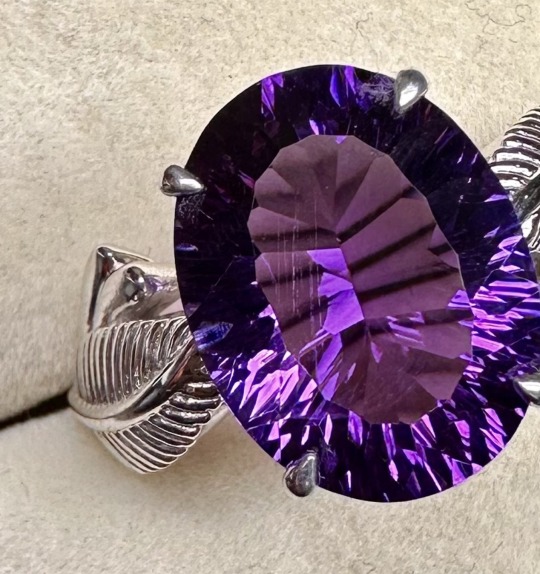
When you go shopping in a jewelry store, it’s best if you have an idea in mind. This way, when the associate comes over and tries to make you buy something bigger and more expensive, you can fire back with your own questions. The Gemological Institute of America wants everyone to know about the four C’s of stone buying: color, cut, clarity, carat. Every stone goes through different hues and shades on a color chart. Sapphires range from black to bright blue, green, and pink. Rubies can be pink all the way to a blood red. The color for each gem factors into price a lot more than you may initially think when you walk into the store. The way the stone is cut also plays a major factor as well. If the cut isn’t right, you won’t get the best sparkle because light won’t bounce around inside of it very well and some shapes are hard to achieve in certain stones. Clarity is the thing you hear people talk about quite often. If you’ve shopped for stones before and heard “VVS” or “IF” they’re talking about how clear the stone is inside. Every crystal is able to have these different materials inside of it called inclusions. Emeralds are known for having a lot of inclusions so the clearer the emerald, the more expensive it is. The same goes for most gems. The more flawless you get, the more the price usually goes up. The scale ranges from Flawless to Included and tells you just how much other stuff will be in your jewel. Finally, you need to think about carat. This isn’t the size of the stone, it’s how much it weighs. One carat of diamond is a different size than one carat of sapphire or labradorite. This is why jewelers use carat weight instead of size. This means they can charge based on the gem material and get the most bang for your buck.
Now I know this is a lot to take in, but don’t worry about it all. You’ll have someone who is there with you to help you design this special piece of jewelry every single step of the way. You control the budget and you have the final say. Right now, if you wanted to go and see a few pieces the CEO has created herself to get some inspiration, you can see four rings here. On the site there is a 2.2 carat peridot in 14kt white gold, a watermelon tourmaline in yellow gold, and two amethysts in the 14kt white gold. The amethysts are priced differently based on that carat weight of the stone, so remember that when you’re designing your own ring. These jewelry pieces come in all whole sizes so make sure you know how to size your rings. And remember, jewelry speaks just like pictures. What story do you want the world to see when they look at your rings?
#birdsofvalhalla#handmade soap#natural soaps#small business#norse#norse pagan#norse theme#custom jewelry#custom ring#jewelry#jewelry design#gemstones
2 notes
·
View notes
Text
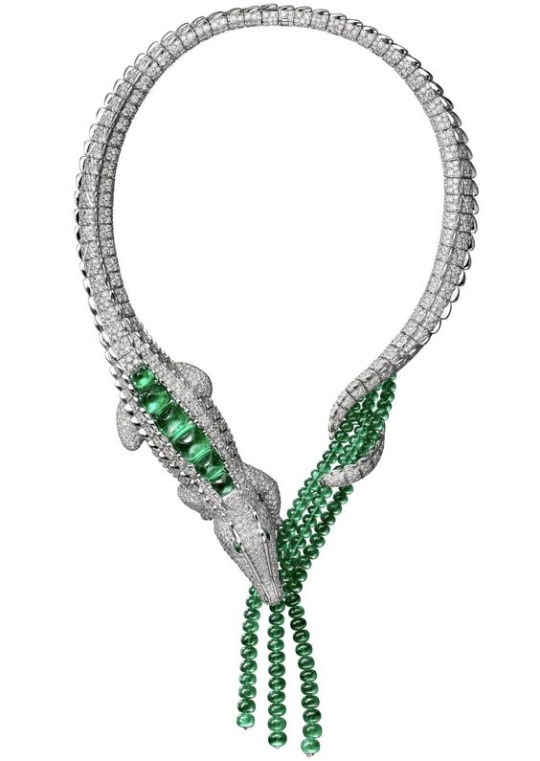
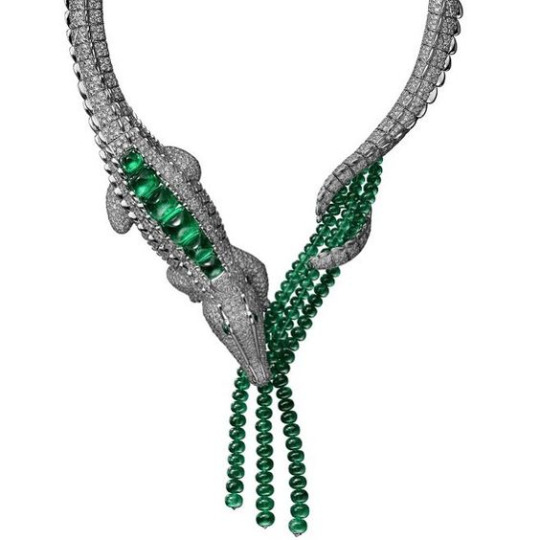
Alligator in Columbian Emeralds & Diamonds by Cartier
The Cartier Maria Felix High Jewelry Suite Crocodile Necklace, scupted in white gold, set with diamonds and six rare quality cabochon-cut emeralds from Colombia. The crocodile clutches the three strands of emerald beads entwined from its tail.
Cartier Unveils Four Maria Felix High-Jeweled Crocodile Masterpieces With Rare Colombian Emeralds - by Roberta Naas
1 note
·
View note
Text
Gemstone Glow Up: Trending Jewelry Styles that Rock!
Forget plain ol' necklaces, tumbler fam! Dive headfirst into the vibrant world of sparkling gemstones and the hottest jewelry trends rocking the scene. Get ready to polish your knowledge and add some serious bling to your feed!
Gemstone Superstars:
Moissanite: This near-diamond dazzler steals the show with its fiery brilliance and budget-friendly price tag. Watch out for cushion cuts and delicate halo settings!
Opals: Mystical and mesmerizing, opals are back in a big way. Think rainbow flashes, cabochon cuts, and statement rings that steal the spotlight.
Lab-grown Gems: Eco-conscious and ethically sourced, lab-grown gems like emeralds and sapphires are trending for their vibrant colors and guilt-free sparkle. Embrace geometric cuts and unique settings!
Cuts that Captivate:
Baguette Cuts: Long and sleek, baguette cuts add a modern edge to classic gemstones. Stack 'em up or let them shine solo for a minimalist statement.
Emerald Cuts: Sophisticated and elegant, emerald cuts are making a comeback in earrings and pendants. Channel vintage vibes with gold settings or go bold with colored gemstones.
Unconventional Cuts: Pear, marquise, trillion – unique cuts are all the rage! Show off your individuality with playful designs and unexpected gemstone choices.
Settings that Sizzle:
Bezel Bliss: Clean and sophisticated, bezel settings hug your gemstone for a sleek and modern look. Perfect for everyday wear and showcasing natural beauty.
Cluster Craze: Pile on the sparkles with cluster settings! These playful designs feature multiple gemstones in one piece, creating a dazzling explosion of color and texture.
Hidden Halo Heaven: Add a touch of unexpected brilliance with hidden halo settings. A delicate ring of smaller gemstones sits beneath the main stone, amplifying its sparkle from within.
Bonus Tip: Get creative! Mix and match trends, experiment with metals (rose gold is hot!), and personalize your jewelry to reflect your unique style. Don't forget to use relevant hashtags like #gemstonejewelry #jewelrytrends #tumblerjewelry to rock the blogosphere!
Remember, it's all about expressing yourself and letting your inner sparkle shine. So grab your gemstones, unleash your creativity, and join the trending jewelry revolution! ✨
0 notes
Text
What Sets Buccellati's Pieces Apart?
Remaining true to Mario's innovative manufacturing techniques, Buccellati's craftsmanship showcases elaborate gold embellishments, textures influenced by Venetian lace, Etruscan motifs, and designs inspired by the beauty of flowers, insects, and animals found in nature. The Estate Buccellati Jewelry is crafted using the finest precious metals and gemstones available.

If you get Buccellati Jewelry for Sale Carmel CA, you should grab the chance.
Trafato or Tylle Creations
This is a technique used to create a pierced gold effect that is often used as a setting for precious stones like cabochons, emeralds, rubies, and rose-cut diamonds. The result is a piece that resembles a honeycomb or delicate lace, giving it a textured and intricate appearance as if the surface has been intricately engraved.
Rigato Finish- The Rigato finish is a distinctive design element commonly found in Buccellati creations. It involves the meticulous carving of parallel lines onto the surface of the precious metal, resulting in a glossy and almost silky appearance. This technique adds a touch of elegance and sophistication to the piece.
Powder/Mirror Compact- Buccellati is renowned for its exceptional craftsmanship and attention to detail, not only in jewelry but also in other items like makeup compacts. The compacts created by Marion and Gianmaria Buccellati, especially during the period from the 1920s to the 1950s, are highly sought after as valuable investment pieces. An exquisite example is the vintage diamond 18K yellow gold compact box from the 1940s, designed by Mario Buccellati. It features a diamond accent closure in 18K white gold adorned with rose-cut diamonds. The case itself is crafted in Buccellati's signature lattice style design using 18K yellow gold, showcasing the brand's timeless elegance.

Inspired From Nature
Nature serves as a constant source of inspiration for the exquisite designs of Buccellati jewelry. From delicate flowers to graceful animals and intricate insects, our pieces beautifully capture the essence of the natural world. Take, for example, our vintage thistle flower gold and silver clip-back earrings, which exude timeless elegance. And let's not
forget our latest addition, the remarkable Mario Buccellati 18K Yellow Gold Maple Leaf Pendant Necklace, a true testament to the unparalleled craftsmanship and attention to detail that Buccellati is renowned for.
Wrapping Up
Buccellati jewelry is not only a symbol of luxury but also a wise investment. In 2019, WWD reported on the most expensive fashion-related items listed for sale. Jewelry reigned supreme on the list, and Buccellati proudly claimed a place of honor. Our collier, priced at $106,575, a Buccellati collar at $106,500, and a ring at $78,517 secured the sixth position. This recognition further solidifies Buccellati's status as a brand synonymous with opulence and prestige.
0 notes
Text
Cabochon Cut Emerald Promise Ring, Rustic Women Gold Ring, Vintage Diamonds Proposal Ring, Bridal Jewelry, Engagement Ring, Anniversary Gift
https://www.etsy.com/listing/1637897613/cabochon-cut-emerald-promise-ring-rustic
Embrace timeless elegance with our Cabochon Cut Emerald Promise Ring, a captivating piece that seamlessly blends rustic charm with feminine grace. This exquisite women's gold ring features a lustrous cabochon-cut emerald, evoking a vintage allure that makes it the perfect gemstone proposal ring or a distinctive choice for bridal jewelry. The enchanting design is a testament to enduring love, making it an ideal engagement ring to symbolize the commitment between two hearts.

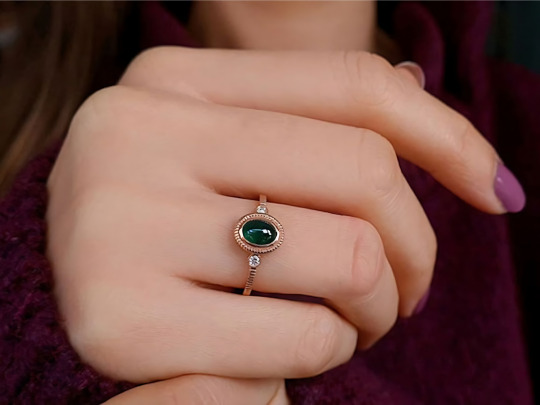
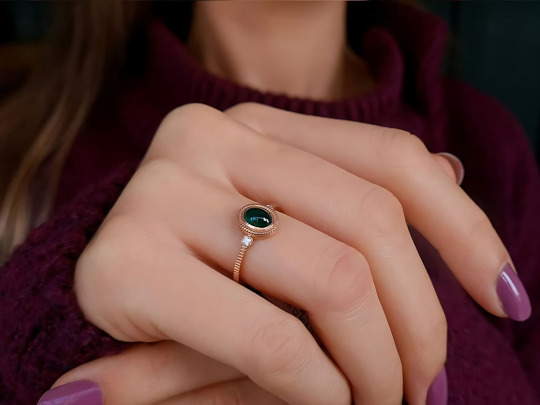
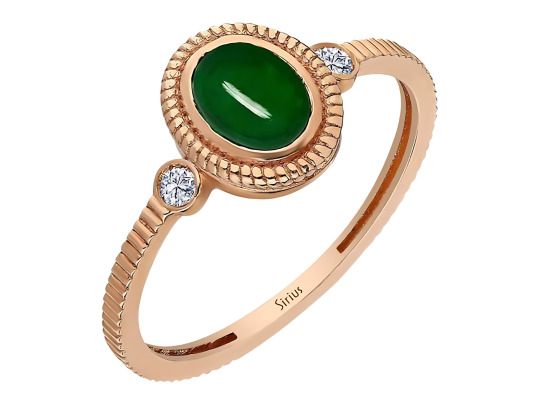


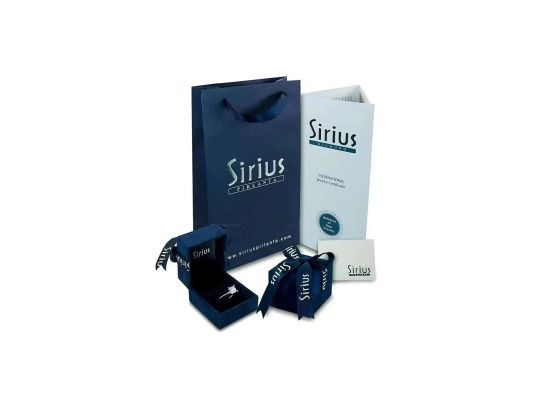
#WomenRing#EmeraldRing#CabochonRing#VintageRing#WeddingRing#RusticRing#EngagementRing#GoldRing#DiamondsRing#PromiseRing#ProposalRing#BridalJewelry#AnniversaryGift
0 notes
Photo
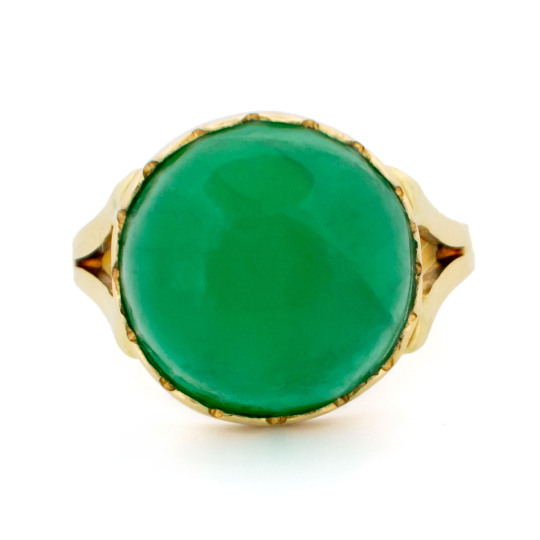
Emerald 14k Solitaire Ring 14411-8325
This mid 20th century solitaire ring encapsulates the era’s elegance. Nestled within its setting is a breathtaking 10.00ct cabochon-cut emerald 🌿, radiant against yellow 14k gold. Cafted by Adamse, C.N. of Utrecht, Voorschoten, and Bergen,The Netherlands, it’s a piece steeped in history and artistry. 💍🕰️ By Adamse, C.N. Utrecht / Voorschoten / Bergen.
Details: ±10.00ct Emerald, 14k Ring, By Adamse, C.N. Utrecht / Voorschoten / Bergen.
Design Era: Mid 20th Century (1950-1970).
Size: 17.53 NL / 55.1 FR / 7¼ US / O UK, sizeable (Within reason. Contact seller for information).
Dimensions: H 0.5 x L 1.5 x W 1.5 cm.
Weight in grams: 5.4.
Condition: Very good condition - slightly used with small signs of wear.
This superb piece ships from our store in the center of Amsterdam, The Netherlands.
We offer both registered shipping and local pickup at our store, with any applicable shipping costs refunded in the case of local pickup.
Add some sparkle to your style with Binenbaum.com. We offer a stunning selection of antique and vintage jewelry that you won't find anywhere else. Whether you're looking for a timeless ring, a dazzling necklace, or a unique brooch, we have something for every taste and occasion. Visit our website today and treat yourself to a piece of history.
https://www.binenbaum.com/product/emerald-14k-solitaire-ring-14411-8325/
#14k#14k ring#amsterdam#antique jewellery#antique jewelry#binenbaum antiques jewelry#bridal#bridaljewellery#bridetobe#emerald#emerald ring#engagement#engagementring#gettingmarried#ido#iloveyou#isaidyes#loveyou#mid 20th century ring#selflove#shesaidyes#spiegelkwartier#vintage jewellery#vintage jewelry#weddingband#weddingring
1 note
·
View note
Text
100% NATURAL EMERALD 8×10 MM OVAL ROSE CUT- AAA QUALITY EMERALD FACETED CABOCHON

*https://gemsstopper.com/gemstones/
*https://gemsstopper.com/product-category/emerald/
*https://gemsstopper.com/product-category/amethyst/
NATURAL EMERALD
The Most Popular Green Gemstone
Natural Emerald is a green variety of the mineral beryl. It is the most popular green gemstone and is known for its beauty and rarity. Natural Emeralds are found in a variety of colors, ranging from light green to deep green. The most valuable emeralds are those with a deep, vivid green color.
Natural Emeralds are also known for their inclusions, which are small defects that can be seen in the stone. However, inclusions do not necessarily decrease the value of an emerald. In fact, some collectors prefer Natural emeralds with inclusions because they believe that they add character to the stone.
THE HISTORY OF EMERALDS
Natural Emeralds have been prized for centuries. They were used by the ancient Egyptians, Greeks, and Romans. Emeralds were also used by the Aztecs and Mayans. In the Middle Ages, emeralds were believed to have magical powers. They were said to protect against evil and to bring good luck.
THE PROPERTIES OF EMERALDS
Natural Emeralds are a member of the beryl family, which also includes aquamarine and morganite. Natural Emeralds are the hardest gemstone in the beryl family. They have a Mohs hardness of 7.5 to 8. This means that they are only slightly softer than diamonds.
Natural Emeralds are also a relatively dense gemstone. They have a specific gravity of 2.67 to 2.77. This means that they are heavier than many other gemstones.
THE VALUE OF NATURAL EMERALDS
The value of emeralds is determined by a number of factors, including color, clarity, cut, and carat weight. The most valuable emeralds are those with a deep, vivid green color. Emeralds with inclusions are generally less valuable than those without inclusions. However, some collectors prefer emeralds with inclusions because they believe that they add character to the stone.
The cut of an emerald is also important. Emeralds are often cut in a step cut, which helps to bring out their color and clarity. Emeralds can also be cut in a cabochon or pear shape.
The carat weight of an emerald is also important. Larger emeralds are generally more valuable than smaller emeralds. However, the value of an emerald is not always directly proportional to its carat weight. An emerald with a deep, vivid green color and few inclusions may be more valuable than a larger emerald with a lighter color and more inclusions.
THE EMERALD TRADE
The emerald trade is a global industry. The largest producers of emeralds are Colombia, Brazil, Zambia, and Russia. Emeralds are also found in other countries, such as Afghanistan, India, and Madagascar.
The Colombian emeralds are considered to be the finest in the world. They are known for their deep, vivid green color and their clarity. The Brazilian emeralds are also highly prized. They are known for their large size and their beautiful color.
The emerald trade is a complex industry. There are many different players involved in the trade, including miners, cutters, dealers, and jewelers. The emerald trade is also subject to a number of regulations, including those that govern the mining and export of emeralds.
GREEN EMERALD
EMERALD GREEN IS A DEEP, VIBRANT GREEN COLOR THAT IS OFTEN ASSOCIATED WITH NATURE AND REGENERATION. IT IS A POPULAR COLOR FOR JEWELRY, HOME DÉCOR, AND FASHION. EMERALD GREEN IS ALSO SAID TO HAVE CALMING AND HEALING PROPERTIES.
EMERALD STONE
Emerald is a green assortment of the mineral beryl. It is the most famous green gemstone and is known for its excellence and extraordinariness. Emeralds are tracked down in various varieties, going from light green to dark green. The most significant emeralds are those with a profound, distinctive green tone.
Emeralds are likewise known for their considerations, which are little imperfections that should be visible in the stone. Nonetheless, incorporations don’t be guaranteed to diminish the worth of an emerald. As a matter of fact, a few gatherers favor emeralds with incorporations since they accept that they add character to the stone.
Emeralds have been valued for a really long time. They were utilized by the old Egyptians, Greeks, and Romans. Emeralds were likewise utilized by the Aztecs and Mayans. In the Medieval times, emeralds were accepted to have enchanted abilities. They were said to safeguard against evil and to bring best of luck.
The emerald is the birthstone for May. It is additionally the customary gemstone for twentieth and 35th wedding commemorations.
Emeralds are a well known decision for gems. They are many times set in rings, pieces of jewelry, and hoops. Emeralds can likewise be utilized in other enhancing objects, like puppets and containers.
On the off chance that you are thinking about purchasing an emerald, doing your research is significant. There are various elements to consider, like the variety, lucidity, cut, and carat weight of the stone. You ought to likewise know about the various kinds of emeralds that are accessible, like Colombian emeralds and Brazilian emeralds.
Emeralds are a wonderful and uncommon gemstone that has been valued for quite a long time. They are a famous decision for gems and beautifying objects. On the off chance that you are searching for a gemstone that is both lovely and significant, the emerald is an incredible choice.
#Natural Emerald#Emerald#Emerald Cut#Emerald Faceted#Amethyst Gemstone#amethyst rings#amethyst meaning#amethyst crystal#Gemstones#Natural gemstones#Handcrafted gemstones#Unique gemstones#Rare gemstones#Precious gemstones#Semi-precious gemstones#Gemstone jewelry#Gemstone necklaces#Gemstone bracelets#Gemstone earrings#Natural Gemstone#Natural Color#Faceted Gemstone#Calibrated Gemstone#Gemmy#Gems#Gem#Gemstone Pendant#Gemstone Cabochon#Loose Gemstone#Gift for Her
0 notes
Link
Check out this listing I just added to my Poshmark closet: 90’s Joan Rivers Medieval Cross Pin/Brooch.
0 notes
Text
How to select reliable wholesale gemstone suppliers?
Wholesale Gemstone Suppliers and Gemstone Jewelry Manufacturers India: Gem Factory India stands out as a premier Gemstone wholesale Supplier and Gemstone Jewelry Manufacturers ,catering to a wide range of precious and semi-precious Gemstones.we take pride in being a trusted exporter of wholesale gemstones with varieties of diamonds, emeralds,Rutilated Quartz,Aquamarine,Cabochons,tsavorite,Garnet etc. Suppliers of Wholesale Gemstone Beads, Raw Crystals,Natural Pearls,Rhodonite to customers worldwide.
Natural gemstones add a fine touch of elegance to jewelry pieces by enriching their beauty. Counted among the top Wholesale Gemstone Suppliers & dealers, we provide a vast and diverse variety of precious stones and semi-precious gemstones to worldwide buyers. Marked by affordability, excellence, and durability our brand enjoys a distinguished position.
Buy Wholesale Precious Stone, Semi Precious Stone, Gemstone Beads and Jewelry From Best Online Gem Factory India.With our extensive selection and expertise in the field, we have earned a reputation as a top-notch source for gemstones in the industry.With our extensive experience and expertise in the gemstone industry, we have established ourselves as a reliable source for high-quality gemstones at competitive wholesale prices. When searching for Manufacturers of 925 silver jewelry or Gemstone Jewelry Suppliers , Our team stands with you as the best manufacturing company .
Gem Factory India presents a beautiful collection of high-quality natural loose gemstones for jewelry making direct from the Wholesale Gemstone Suppliers & dealer in all popular shapes, calibrated sizes, cuts & qualities that have been sourced for you from many exotic locations around the world. All the gemstones found in this collection are cut & polished by skilled craftsmen of Jaipur, India thus giving you complete quality assurances.
During your communication with Wholesale Gemstone Suppliers, it is essential to clearly communicate your customization needs, including gemstone type, cut, size, color, and any specific design elements. Inquire about their design process, turnaround times, minimum order quantities, and pricing structure for custom orders. This will help you determine if the supplier is the right fit for your needs.
What can be the best things you can find from the Wholesale Gemstone Supplier’s Stores:
Wholesale Gemstone Beads: One of the remarkable qualities of gemstone beads is the vast array of gemstone types available. From popular gemstones like amethyst, turquoise, and citrine to more rare and exotic options such as labradorite, larimar, and charoite, each gemstone possesses its unique character and energy.
Wholesale Crystals: We are proud suppliers of Wholesale Crystals, catering to the needs of retailers, crystal enthusiasts, and holistic practitioners worldwide.
Cabochons Gemstone Suppliers: Inventory features a vast assortment of cabochon gemstones in various types, sizes, and colors. From classic gemstones like opal, turquoise, and moonstone to unique and rare options such as labradorite, larimar, and charoite, our collection encompasses a wide range of choices to cater to different design preferences.
Wholesale Rough Gemstone Suppliers: We take great pride in providing a wide range of raw and uncut gemstones to meet the needs of gemstone enthusiasts, lapidaries, and Jewelry Manufacturers. With our extensive selection of high-quality rough gemstones and a commitment to exceptional service, we aim to be your trusted source for all your wholesale rough gemstone requirements.
Conclusion:
When contacting potential suppliers, be prepared with specific questions about their products, pricing, minimum order quantities, shipping policies, and return/exchange policies. Compare multiple suppliers to find the one that best fits your requirements in terms of quality, pricing, and reliability. When searching for Custom Jewelry Manufacturers, it is important to do your due diligence. Start by looking into jewelry wholesalers and suppliers, Private Label Jewelry Manufacturers, and any other relevant companies that specialize in making custom jewelry. Make sure you read reviews of each company and get a list of references. Look into the company's portfolio to see if they have created pieces that are similar to what you are looking for. It's also important to research the materials they use and how long it typically takes them to make a piece. Lastly, compare prices between different companies to make sure you're getting the best deal.
0 notes
Text
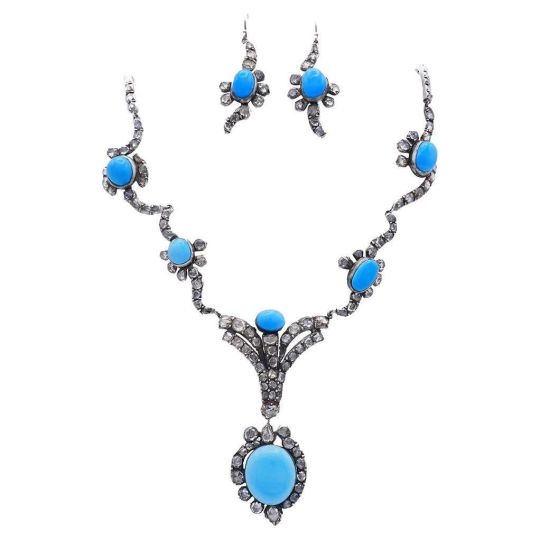
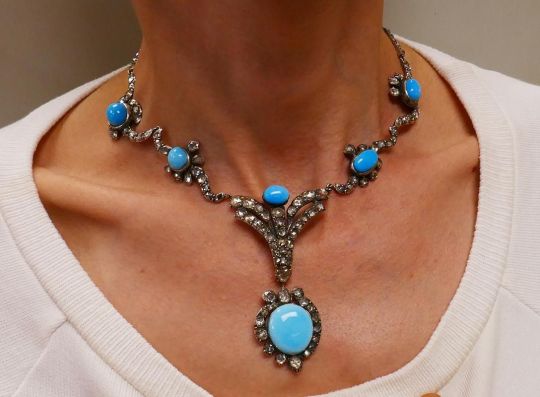
Antique Victorian Persian Turquoise Necklace Earrings Set Diamond Silver
A gorgeous antique set featuring Persian turquoise and rose cut diamond staged in silver. The Victorian set is consisted of a necklace and earrings. The Victorian dangling earrings have floral design and are equipped with a hook closure. Rose cut diamonds add a subtle sparkle while the turquoise splashes an amazing color. The Victorian necklace is comprised of six smaller turquoises with a large one hanging in the middle. All the stones have a lovely, clean baby blue color. This antique set looks delicate and very feminine with the diamond “petals” creating a great icy effect. The workmanship of the set is outstanding. The curved elements are thoughtfully mixed with the bar parts. All the features of the necklace are connected skillfully, and it sits perfectly on a neck. This antique Victorian set is made of silver and features eight oval cabochon Persian turquoise and rose cut diamonds. Measurements: 14 ½” x 1/8". The flower parts 5/8” x ¾”. The pendant part 2 7/8" x 1". The largest turquoise 5/8” x ¾” (2 x 1.7 cm), the other turquoise from ½” x 3/8” (1.3 x 1 cm) to 3/8” x ¼” (1 x 0.8 cm). The earrings 2” x ¾” (5 x 2 cm) with the hook. The weight is 75.9 grams. Did you know that in 17th century wearing turquoise jewelry was a must for a well-dressed gentleman? The stone was popular to the point when all of the emeralds in the crown that Napoleon I gave Empress Marie Louise were replaced with Persian turquoise cabochons. Today Persian turquoise is beloved by jewelry aficionados for its warm, calming color. It may vary from sky-blue to green. As to the dark veins, it depends on your preferences and a certain piece. Some jewelry collectors prefer turquoise with web pattern of matrix as it adds character to a piece. The name “turquoise” came from the "pierre tourques" that translates as a “Turkish stone.” The mineral was first transported to the west through Turkey from mines in the historical Khorasan province of Iran (Persia) and Afghanistan. Pre-Columbian Native Americans mined the stone throughout nowadays. In all these cultures turquoise was considered as a protective stone for warriors and symbolized the connection to the heaven.
Details
Metal
Silver
Stone
Turquoise,Diamond
Stone Cut
Mixed Cut
Weight
75.9 g
Dimensions
Width: 0.75 in (19.05 mm)Length: 14.5 in (368.3 mm)
Place of Origin
Unknown
Period
Early 20th Century
Date of Manufacture
1900s
Condition
GoodWear consistent with age and use.
0 notes